Nicole Frederickson, a middle school teacher, doesn't believe in diagnostic writing assessments at the beginning of the school year. Find out why she builds a community of writers before she assesses her students.![]()
Viewing: Blog Posts Tagged with: Assessment, Most Recent at Top [Help]
Results 26 - 50 of 77
Blog: TWO WRITING TEACHERS (Login to Add to MyJacketFlap)
JacketFlap tags: guest blogger, assessment, Add a tag
Blog: TWO WRITING TEACHERS (Login to Add to MyJacketFlap)
JacketFlap tags: assessment, primary grades, on-demand piece, Add a tag
How much time do you think K-2 students need to complete an on-demand narrative writing assessment? ![]()
Blog: TWO WRITING TEACHERS (Login to Add to MyJacketFlap)
JacketFlap tags: assessment, on-demand piece, norming meeting, Add a tag
I've administered and reviewed many on-demand pieces of writing. However, I've never engaged in a norming meeting until two weeks ago. Learn more about the ways in which we can work with our colleagues to assess on-demand assessments so they can drive our instruction.![]()
Blog: TWO WRITING TEACHERS (Login to Add to MyJacketFlap)
JacketFlap tags: assessment, on-demand piece, norming meeting, Add a tag
I've administered and reviewed many on-demand pieces of writing. However, I've never engaged in a norming meeting until two weeks ago. Learn more about the ways in which we can work with our colleagues to assess on-demand assessments so they can drive our instruction.![]()
Blog: The Open Book (Login to Add to MyJacketFlap)
JacketFlap tags: Resources, assessment, goal setting, Curriculum Corner, setting reading goals, guided reading, magic three, student motivation, Add a tag
Empowerment Post-Assessment
![]() Jaclyn DeForge, our Resident Literacy Expert, began her career teaching first and second grade in the South Bronx, and went on to become a literacy coach and earn her Masters of Science in Teaching. In this series for teachers, educators, and literacy coaches, Jaclyn discusses different strategies for ensuring students hit end-of-year benchmarks in reading.
Jaclyn DeForge, our Resident Literacy Expert, began her career teaching first and second grade in the South Bronx, and went on to become a literacy coach and earn her Masters of Science in Teaching. In this series for teachers, educators, and literacy coaches, Jaclyn discusses different strategies for ensuring students hit end-of-year benchmarks in reading.
Two weeks ago, I shared with you some resources to use when determining a reading goal for each student, and last week I talked about how to motivate students about their reading goal and about how to 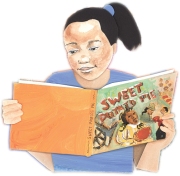 schedule out regular assessment. Today, I want to get into the nuts and bolts of the running record assessment time, and how to create a post-assessment conference that really empowers students.
schedule out regular assessment. Today, I want to get into the nuts and bolts of the running record assessment time, and how to create a post-assessment conference that really empowers students.
The first part of my assessment time with each individual student is the assessment itself. Once I’ve determined the student’s independent reading level (each assessment program differs in terms of what a student needs to score to be considered independent), I take out a secondary assessment kit and read with the student on their instructional level to determine each student’s “Magic Three.” The “Magic Three” are the three reading comprehension skills and strategies I’m going to send that student off with to focus on during their independent reading time between now and the next assessment.
When reading with a student on their instructional reading level, I consider the following:
“The word reading has two senses, often confusingly lumped together. The first means the process of turning printed marks into sounds and these sounds into words. But the second sense means the very different process of understanding those words. Learning how to read in the first sense—decoding through phonics—does not guarantee learning how to read in the second sense—comprehending the meaning of what is read…[c]hildren who lag in comprehension in early grades tend to fall even further behind in later years.”
E.D. Hirsch, Jr. The Knowledge Deficit
Different running record assessment systems have different accuracy benchmarks, but when I do running record with a student, only a small percentage of what I’m looking for has to do with decoding. On the whole, I’ve found students can decode at a far higher level than they can comprehend, so this usually isn’t a factor when dealing with a student’s instructional level. What I look for is: a) do they comprehend the story on a BASIC level? and b) how much of the story were they able to EXTEND to comprehend on a deeper level? Most students, when they’re reading at their instructional level, may have a few minor problems with the basic comprehension, but really tend to st
Blog: SSPP Reads (Login to Add to MyJacketFlap)
JacketFlap tags: Assessment, Catholic Schools, formative, IOWAs, Riverside Publishing, standardized, summative, Add a tag
 Here is a re-post of my blog from last year on standardized testing. It begins next week at Sts. Peter & Paul School. The Department of Catholic Schools uses the Iowa Test of Basic Skills (IOWAs), a norm referenced battery of standardized tests, every fall in the Archdiocese of San Francisco.
Here is a re-post of my blog from last year on standardized testing. It begins next week at Sts. Peter & Paul School. The Department of Catholic Schools uses the Iowa Test of Basic Skills (IOWAs), a norm referenced battery of standardized tests, every fall in the Archdiocese of San Francisco.  According to IOWA test publishers Riverside Publishers, fall testing is more desirable than spring testing.
According to IOWA test publishers Riverside Publishers, fall testing is more desirable than spring testing.
Two important uses of test scores are to check year-to-year progress and to determine areas of relative strength and weakness. To accomplish these purposes most effectively, test results must be available early enough in the school year so that teachers and administrators have a chance to incorporate this diagnostic information into their instructional decisions.
Diagnostic information . . . and remediation strategies can be developed based on the information from fall testing. Used properly, these results offer a predictable glimpse of which students are most at risk of not meeting academic performance goals. . . (and) allows districts to effectively use test results in a collaborative way.
Longitudinal patterns can be used to focus professional development strategies or determine instructional areas that need additional resources.
- Stay positive
- Relax
- Pace yourself
- Review your answers
- Enjoy a healthy snack and maintain a balanced diet
- Get a good night’s sleep
- Get some exercise
Good luck!
Graphic from open source images englishtutors.languagespirit.com
Blog: Amsco Extra! (Login to Add to MyJacketFlap)
JacketFlap tags: Math, Assessment, Mathematics, Standardized Tests, Add a tag

 The problem was in the 2-point, or short answer free response, portion of the exam, testing the learning standard that demands students “determine the inverse of a function and use composition to justify the result.” (A2.A.45) The wording of the question strongly implies that the inverse of the function does indeed exist. However, since the function given is not one-to-one, there is no inverse. Teachers got loud, complaining to representatives of the Board of Regents, the group that writes, edits, and distributes the exam. The Board responded with a memo called, “Scoring Clarification for Teachers,” which acknowledged several ways that students could interpret the question and demonstrate their understanding of invertibility of functions.
The problem was in the 2-point, or short answer free response, portion of the exam, testing the learning standard that demands students “determine the inverse of a function and use composition to justify the result.” (A2.A.45) The wording of the question strongly implies that the inverse of the function does indeed exist. However, since the function given is not one-to-one, there is no inverse. Teachers got loud, complaining to representatives of the Board of Regents, the group that writes, edits, and distributes the exam. The Board responded with a memo called, “Scoring Clarification for Teachers,” which acknowledged several ways that students could interpret the question and demonstrate their understanding of invertibility of functions.Was the response satisfactory? The Board's memo cites “variations in the use of [inverse] notation throughout New York State,” which seems to evade blame for a lousy question. A prominent math teacher blogger responded on his blog, “How could the test-makers not be aware of ‘variations in notation’? Also, notice how there is an asymmetric justification burden on a kid claiming (correctly) that the inverse does not exist.” A lousy question shakes the faith that teachers and students have in the standardized test as a valid assessment of student understanding. For instance, the same blogger concluded, “I have no confidence in New York State’s ability to create a good test of mathematics, at any level.”
It is my sincere hope that this controversy and the appearance of a misleading question will lead to both (a) more opportunities to explore the meaning of invertible functions and one-to-one functions, demanding students to be more savvy test-takers; and (b) increased scrutiny and more careful construction of New York’s Regents exams. In short, as educators, better instruction and better assessment should be our smart answer to this, or any, stupid question.
Blog: Amsco Extra! (Login to Add to MyJacketFlap)
JacketFlap tags: Assessment, Mathematics, Critical Thinking, Accessiblity, Opinion, Teaching, Math, Research, Add a tag
Imagine, however, a soccer team that drills all day long but never actually competes. Such a team would be like the North Korean soccer team who allowed 12 goals in a mere three games in the World Cup. (To put things in perspective, the winning team, Spain, scored a total of 8 points for all 7 games of the World Cup. Ouch.) At the other extreme, imagine a team that plays against other teams all the time but never actually practices as a team. That sounds a lot like England at the World Cup.
But what does all this have to do with Direct Instruction? Math is all about problem solving, and by "problem solving," I mean solving problems that require critical thinking. Of course, to solve problems, you need practice, practice, practice, and mastery of underlying content. A student who always drills (practices on straightforward problems) but never actually uses her critical thinking skills is like the team that always practices but never competes. At the other extreme, a student that always tries "challenging" problems but never actually drills is like the team that always competes but never practices. Neither is a successful learning strategy. A good teacher needs to find the right balance between the two for his classroom.
It is apparent, however, that blindly applying either Direct Instruction or its archnemesis—a discovery-orientated approach—can lead to both extremes. So, let's examine what works with Direct Instruction.
My favorite Direct Instruction strategy is the careful examination of pre-skills. For a gi
Blog: Amsco Extra! (Login to Add to MyJacketFlap)
JacketFlap tags: Technology, Math, Assessment, Mathematics, Add a tag
Now what does this have to do with evaluating education software (such as test generators)? Well, it turns out that in my first try I was using the computer as a crutch. I mistakenly assumed that the computer would somehow auto-magically churn out “good” problems.
For instance, take the simple task of creating problems that ask students to convert a percent to a decimal. Sounds easy, right? Churn out a bunch of random numbers, tack on a “%”, and voilà you are done. Unfortunately, if you want a good practice set, you need to make sure different types of percents are covered: percents greater than 100%, percents less than 1%, percents with a decimal point (ex: 24.5%), etc. Moreover, depending on the grade level, you may wish to skip some of these percent types. Hence, the first tip:
Tip #1. Think very hard about the types of problems you want (appropriate discriminating examples). Make sure the software can give you those problems.The second tip is related to style. Consider these computer-generated equations testing one-step addition/subtraction over the integers:
- x + 2 = 10
- x – 3 = 12
- x – 7 = –5
- x + 16 = –12
- x + 10 = 2
- x – 5 = –7
- x + 12 = –16
Tip #2. Make sure the software tests students on a sufficient range of problem formats.To conclude, don’t make the false assumption that computer software automatically produces good material. As you do when you evaluate&nbs
Blog: Amsco Extra! (Login to Add to MyJacketFlap)
JacketFlap tags: NCTM, Metacognition, Podcasts, Assessment, Mathematics, Add a tag

“The most powerful learning experiences often result from making mistakes,” says Deb Russell, a mathematics educator and consultant. She claims that introducing work with errors to students encourages them to consider why a method works, as opposed to stopping as soon as they see how the method works, deepening conceptual understanding as they develop computational and algorithmic fluency.
Blog: TWO WRITING TEACHERS (Login to Add to MyJacketFlap)
JacketFlap tags: poetry, assessment, georgia heard, Add a tag
Our first Guest Blog Post of the summer is written by Sarah Mulhern, who is a sixth grade teacher in New Jersey. Sarah blogs at The Reading Zone. When Stacey first asked me to write a guest blog for Two Writing Teachers I immediately accepted. Then I realized I would have to think of something [...]
Blog: YALSA - Young Adult Library Services Association (Login to Add to MyJacketFlap)
JacketFlap tags: Economy, Teen Services, Evaluation, Dollars & Sense, ROI, Assessment, Add a tag
Yesterday Beth Gallaway wrote about Return on Investment (ROI) and how to make sure to get a good bang for your buck. Beth’s specific focus was on how gaming provides great opportunities to demonstrate ROI.
Continuing on the theme of ROI, how do you:
- Make sure that administrators, community members, foundations, grant makers, etc. understand the value of all aspects of the job that you do?
- Demonstrate that the full scope of services for teens is an invaluable part of what the library offers?
- Guarantee that those who have the bucks will make sure that you have dollars that you need when you need them?
In order to prove that the money spent in teen services is a good investment, it’s important to have data and stories that you can present to others. How do you do that? Focus groups, circulation statistics, door counts, and surveys are traditional methods libraries use. But, in the web 2.0/social networking world, there are several other techniques to employ in order to find out what other’s have to say about your services and their value:
- Save searches in Twitter and use services like Google Alerts to keep track of any time the library (and specifically teen services) is mentioned online. These web-based tools give you the opportunity to “hear” what others are saying about what you do, without you even asking for feedback. You can find out what might be improved, and discover the good things others are saying about you. You can collect the online mentions and over time weave them into a story that you tell about the quality and responsiveness of services provided.
- Use a service like Poll Everywhere to get real-time feedback from teens attending events, programs, or meetings at the library. As the activity is going on teens can let you know via SMS what they are thinking.
- Ask for feedback via your library’s blog. After you’ve started a new service at the library, post on the blog about the service and ask teens to let you know what they think about it. In their comments give teens the chance to tell their stories about the value of the service in their own lives.
- Google Forms is a quick and easy way to create online polls that you can embed on your web site or blog. With Google Forms you could easily sponsor a weekly poll that asks teens to tell you about what they need from the library’s teen services, and let you know all the ways you are serving them successfully.
One of the useful features of Google Forms is that the information entered into a poll or survey is automatically added to a spreadsheet. The data collected is also made available via that spreadsheet in visual form. In other words, Google Forms provides you with charts and graphs instantaneously so that you have visualizations of the information provided by teens.
In order to demonstrate ROI it’s important to regularly let others know that you are doing a good job. Data visualizations (such as those provided by Google Forms) are a good way to get that information out to others. To create visualizations of the data you collect you can also use a service like Many Eyes, from IBM. With this service you can upload
Add a CommentBlog: TWO WRITING TEACHERS (Login to Add to MyJacketFlap)
JacketFlap tags: assessment, non-narrative writing, rubric, Add a tag
I was at the computer this morning when my students created a pretty basic rubric for their final unit of study’s essays. The following is what they created. They’ll use it to self-assess their essays and I’ll use it to give them their final grade of the school year.
[...]
Blog: TWO WRITING TEACHERS (Login to Add to MyJacketFlap)
JacketFlap tags: assessment, Add a tag
One. It is constant. The more I learn about student writers, the more I am in a constant state of assessment. Any time I’m around student writers, I’m assessing them. I’m noticing what they are doing well. I’m noticing the ways that are making meaning. I’m noticing the rate at which they are recording their [...]
Blog: TWO WRITING TEACHERS (Login to Add to MyJacketFlap)
JacketFlap tags: assessment, writing workshop, The Big Picture Series, Add a tag
Assessment. Is there anything basic about it? As I’ve lamented about what to post on this topic today, I decided to look back and share how I survived assessing writing when I first began teaching according to the Writing Workshop philosophy nearly nine years ago. Here is a golden nugget:
Assess writing through different lenses.
The first [...]
Blog: TWO WRITING TEACHERS (Login to Add to MyJacketFlap)
JacketFlap tags: narrative, assessment, personal narrative, Add a tag
Today my students turned in their narratives. I couldn’t wait to read them, so I began today during my lunch. I was touched by their writing, and impressed by the significant revisions many of them made.
Tonight (as my kids were coloring) I looked over the narratives again and began to pile them according to strength. [...]
Blog: TWO WRITING TEACHERS (Login to Add to MyJacketFlap)
JacketFlap tags: technology, assessment, rubric, rubrics, Add a tag
Earlier this week, I posted about the process of determining how to attach grades to chats and discussion forums. Before break, my students divided into two groups and determined the areas which should be evaluated when assessing the success of a chat or discussion thread. I took their ideas and created two rubrics. The chat rubric is [...]
Add a CommentBlog: TWO WRITING TEACHERS (Login to Add to MyJacketFlap)
JacketFlap tags: meeting area, don graves, classroom layout, community, assessment, minilesson, furniture, Add a tag
Ro left a comment a couple of days ago asking about meeting areas in upper elementary school classrooms. I’ve been corresponding with her, but thought that it might be useful to open up a bit of my thinking on the site. I believe it was Don Graves who said that having the kids in your [...]
Add a CommentBlog: TWO WRITING TEACHERS (Login to Add to MyJacketFlap)
JacketFlap tags: writing, assessment, Add a tag
Regular readers of this blog might remember how impressed I was with one of my students who artfully mentored her memoir after Cynthia Rylant last month. She’s also been writing some amazing poems this month. So, this is what I just got finished writing on her report card (and I’m all chocked-up): Molly listens [...]
Add a CommentBlog: TWO WRITING TEACHERS (Login to Add to MyJacketFlap)
JacketFlap tags: rubric, Mary Chiarella, memoir, assessment, writing workshop, lucy calkins, Add a tag
When I woke up this morning, I realized I never created an assessment rubric for memoir! My first thought was :How could I forget to do that!??! My second thought was: The Publishing Party is this Friday and there’s no rubric! YIKES! It’s 6:02 a.m., and the problem is finally solved since [...]
Add a CommentBlog: TWO WRITING TEACHERS (Login to Add to MyJacketFlap)
JacketFlap tags: prompts, authentic assessment, assessment, Add a tag
First day back . . . and I had the pleasure of working with all of the 4th & 5th grade teachers in our corporation to SCORE WRITING PROMPTS! (Does the emphasis of the capital letters make it sound all glamorous & fun?) Here’s a few things on my mind after a day of scoring [...]
Add a CommentBlog: A Girl who Creates (Login to Add to MyJacketFlap)
JacketFlap tags: woogie-wednesday, junk-a-doodles, woogie-wednesday, junk-a-doodles, Add a tag

It's Wednesday again and time for Woogie Wednesday. This is where we make one of my found object (Junk A Doodles) pieces.
Here's what we started off with:
I then asked her, what should we make out of all this?
"Diamonds" she said with a smirk on her face. She was wearing a "diamond" ring and she wanted something to match.
I had absolutely no idea what I was going to do, so it took me a while to figure it out and in the meantime she lost interest but did check on me from time to time and hand me pieces of junk to use.
The best thing I could come up with was a cat with diamond stripes and diamonds on the collar. I also did a few stitch lines and am calling it Illustration Friday this week too.
Here's how it turned out:
I'm still working on the Woogie Wednesday site, but prints should be up for sale over the weekend if not before.
And, now some Link Back Love for today:
doobleh-vay.blogspot.com
gailmakiwilson.blogspot.com
danidraws.com
artgirlatl.blogspot.com
donnadoodles.blogspot.com
Blog: A Girl who Creates (Login to Add to MyJacketFlap)
JacketFlap tags: woogie-wednesday, junk-a-doodles, woogie-wednesday, junk-a-doodles, Add a tag

It's Wednesday again and time for Woogie Wednesday. This is where we make one of my found object (Junk A Doodles) pieces.
Here's what we started off with:
I then asked her, what should we make out of all this?
"How 'bout a DUCK!"
OK. I guess we both have birds on the mind today.
She starts picking out which parts will be what and paints the head, beak and paper punches random bits, while I paint the background. She them turns her attention to doing one all by herself and confiscates 2 of the pieces. She made a mouse and thought it was hilarious that I took a picture of it:
And here's how it turned out:
And then here's out finished product. more of a chick than a duck. It would make a cute Valentine's Day card I think.
I'm launching a Woogie Wednesday site next week and we'll be selling prints of our pieces, so stay tuned!
Blog: A Girl who Creates (Login to Add to MyJacketFlap)
JacketFlap tags: junk-a-doodles, Add a tag

Just a little something I did for this month's Highlights Magazine.
Blog: A Girl who Creates (Login to Add to MyJacketFlap)
JacketFlap tags: studio, woogie-wednesday, junk-a-doodles, Add a tag

The past several (SEVERAL!) Woogie Wednesdays have consisted of deadlines for me or the Woog helping me measure, paint and whatnot in the new studio. We didn't do pictures of those days because it really wasn't all that interesting. But now, since the studio is done, this is the first Woogie Wednesday and really the first kind of art (besides those 60 illustrations I had due yesterday) that was done in the studio. And, since we've started late in the day it will continue into a Woogie weekend.
Today, we are working on our Christmas card. We're making a Junk A Doodles snowman:

And the Woog is loving her new studio space. Here she is while the paint is drying:

And I don't like to show a room that's not yet fully decorated (hopefully I'll be able to do that some tomorrow in between projects), but here's a sneak peek at one wall:

View Next 25 Posts









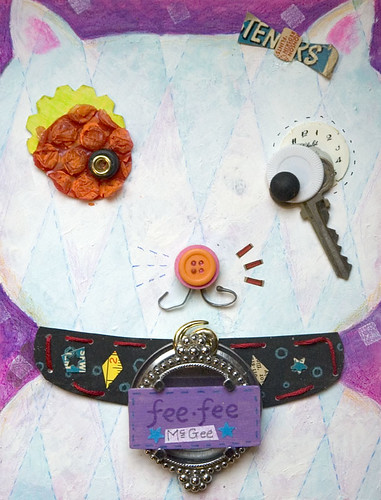
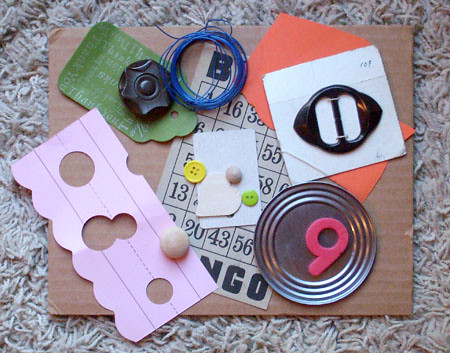
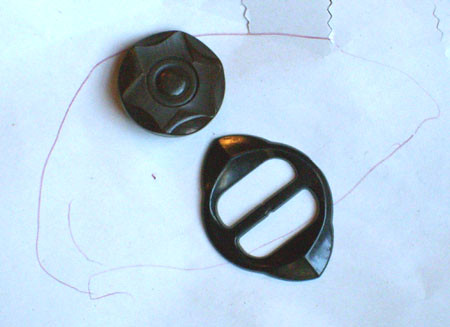
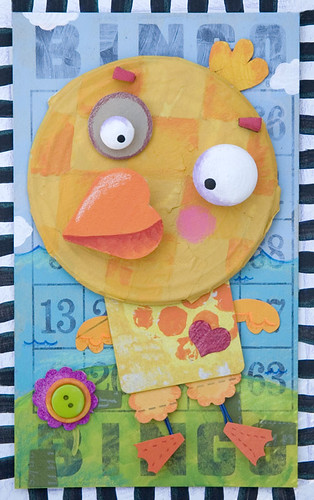
Even Regents make mistakes. That's life. One dud question out of how many? I'm not having a heart attack over this.